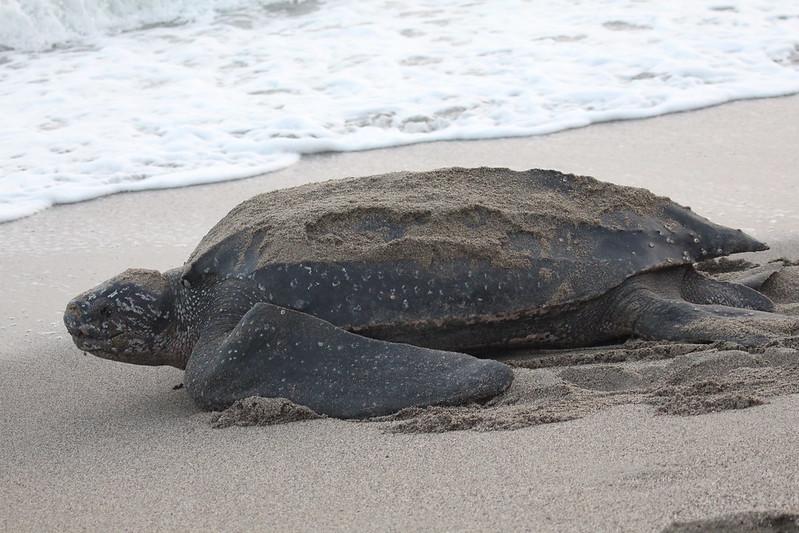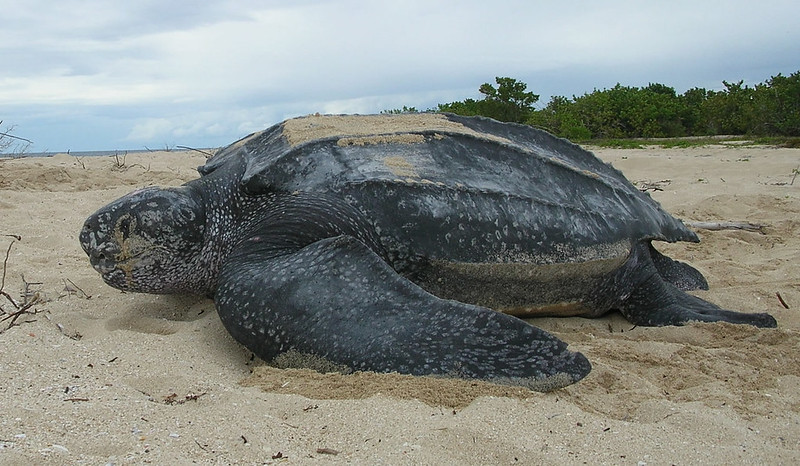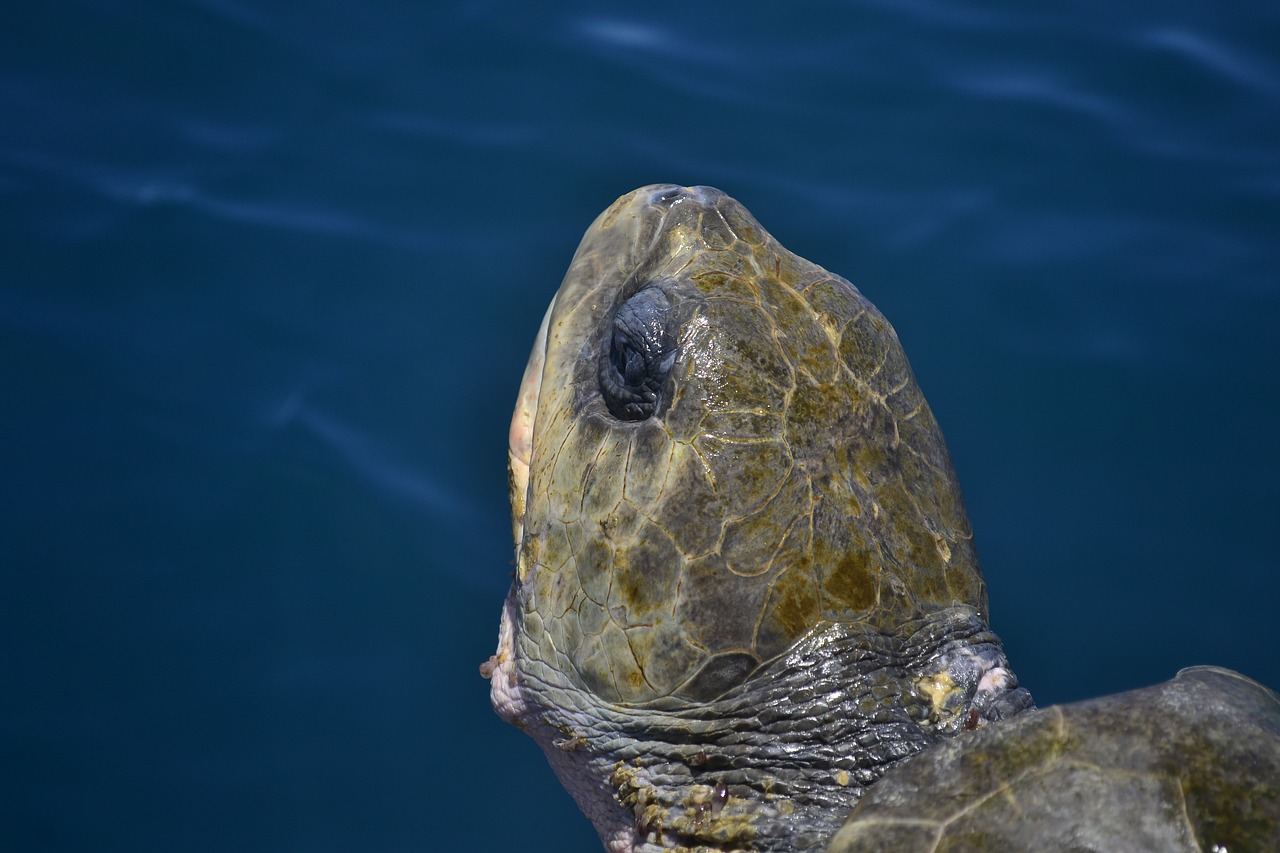The leatherback sea turtle is the only remaining member of an evolutionary family whose ancestry dates back about 100,000 years. Leatherbacks were, in fact, swimming in ancient seas at the same time Tyrannosaurus rex was thundering over the land.
Yet this living giant of the oceans is now under threat from a number of factors in its environment. And all of them are human-made. Here’s what you need to know:
The Leatherback Is the World’s Biggest —and Perhaps Most Unusual —Sea Turtle
The leatherback, which has the scientific name Dermochelys coriacea, is the world’s largest sea turtle species. It weighs up to 2,000 pounds and can be as much as seven feet long. It is the only turtle species that lacks its own hard shell.

The leatherback’s shell is made from a type of rubber-like, sturdy skin. This skin is supported by numerous tiny bone plates. It is this body structure that gives rise to its leathery appearance. All along its carapace, it is black or dark gray or inky blue in color. These colors are interspersed with whitish spots. The adult leatherback shell doesn’t have scales, and its flippers are clawless.
A leatherback’s sleek body and strong front flippers allow it to travel thousands of miles of open ocean, even navigating rapid currents. It is also the only reptile species able to live in waters as cold as 40 degrees Fahrenheit.
The Leatherback Is the Most Well-Traveled Sea Turtle
The leatherback is also the most widely dispersed of all the sea turtle species in terms of its range. It lives mostly out on the open seas across most parts of the world, from the southern edge of Africa all the way up to the latitudes of Alaska and Norway.
Among the most migratory of turtle species, leatherbacks are present in both the Pacific and the Atlantic Ocean. Pacific sub-populations migrate from their nesting grounds in the Coral Triangle—the tropical waters of the western Pacific near Indonesia and the Philippines—all the way to the coastlines of California, a rich source of the jellyfish that form a staple of the species’ diet.
The Leatherback Is One of the Most Endangered Species of Sea Turtle
Population estimates for the current worldwide total number of nesting leatherback females are as low as 36,000. This is a stark decrease from 1980 estimates of 115,000.
Scientists estimate that only about 1 in 1,000 leatherback hatchlings survives to maturity. In some parts of the world, for example, some of the waters near Malaysia, Pacific leatherbacks have disappeared entirely.
The United States listed the leatherback as officially endangered in 1970, in the precursor to the 1973 Endangered Species Act. Internationally, the species is considered “vulnerable,” although many sub-species, like the Southwest Atlantic and the Pacific leatherback, are “critically endangered.”
The Leatherbacks’ Chief Threats Are Caused by Humans
The turtles are often taken up as incidental bycatch in commercial fishing operations, with Atlantic leatherbacks experiencing this at an unsustainable rate. Fishermen commonly looking for tuna, swordfish, and shrimp also ensnare sea turtles of various species. Then there is the intentional seizure of sea turtles for their meat.

Additionally, leatherbacks are susceptible to mistaking dangerous sea-borne human trash, such as plastic bags, for jellyfish. They can perish as a result. Researchers have found leatherback turtles with more than 10 pounds of plastic coiled up in their stomachs. Boat strikes and intensive egg-collection are other examples of ongoing threats to the species’ survival. So is beachfront lighting, which can confuse turtles and lead them away from their nests.
The full extent of the threat posed to leatherbacks by climate change has yet to be understood. Even so, a number of climate factors present known hazards.
These include alterations in seasonal rainfall that can raise sand temperatures at nesting beaches. Elevated temperatures either kill nestlings or drastically alter the gender ratios of those that survive. Rising sea levels can overwhelm nesting grounds, washing eggs out to sea. The ongoing increase in ocean acidity poses an additional threat.
The Leatherback Faces Threats at Every Stage of Life
Leatherbacks confront different sets of threats at every part of their life cycle. These threats can also vary by habitat.
For example, even if a female hatchling is able to avoid poachers and not swallow any plastics early in her life cycle, she will then need to evade fishing gear during her lengthy migration. If that turtle lives to be 15 to 25 years old, she will be sexually mature. Her next challenge is finding a mate in the open ocean before returning to her native nesting grounds to produce the next generation.
At that point, however, coastal debris or inappropriately placed lighting fixtures on the beach may keep her from successfully nesting. Even if she is able to make her nest, it stands the chance of being washed out to sea. The eggs in that nest are also subject to poaching by human collectors. The eggs may also become food for wild animals, or even have their temperatures dangerously elevated by over-warm temperatures.
Rescuing the leatherback from the threat of extinction depends on addressing each of these threat factors, in every kind of habitat.

